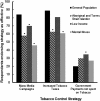A cross-sectional survey of experts' opinions about the relative effectiveness of tobacco control strategies for the general population versus disadvantaged groups: what do we choose in the absence of evidence?
- PMID: 24314097
- PMCID: PMC3890507
- DOI: 10.1186/1471-2458-13-1144
A cross-sectional survey of experts' opinions about the relative effectiveness of tobacco control strategies for the general population versus disadvantaged groups: what do we choose in the absence of evidence?
Abstract
Background: There is a clear disparity in smoking rates according to social disadvantage. In the absence of sufficiently robust data regarding effective strategies for reducing smoking prevalence in disadvantaged populations, understanding the views of tobacco control experts can assist with funding decisions and research agendas.
Methods: A web-based cross-sectional survey was conducted with 192 respondents (response rate 65%) sampled from the Australian and New Zealand Tobacco Control Contacts list and a literature search. Respondents were asked to indicate whether a number of tobacco control strategies were perceived to be effective for each of: the general population; Aboriginal and Torres Strait Islander people; those with a low income; and people with a mental illness.
Results: A high proportion of respondents indicated that mass media and increased tobacco taxation (84% and 89% respectively) were effective for the general population. Significantly lower proportions reported these two strategies were effective for sub-populations, particularly Aboriginal and Torres Strait Islanders (58% and 63% respectively, p's < .0001). Subsidised medication was the only strategy associated with a greater proportion of respondents perceiving it to be effective in disadvantaged sub-populations compared to the general population. Tailored quit programs and culturally relevant programs were nominated as additional effective strategies for disadvantaged populations.
Conclusions: Views about subsidised medications in particular, suggest the need for robust cost-effectiveness data relevant to disadvantaged groups to avoid wastage of scarce tobacco control resources. Strategies perceived to be effective for disadvantaged populations such as tailored or culturally relevant programs require rigorous evaluation so that potential adoption of these approaches is evidence-based.
Figures


Similar articles
-
The balancing act: experts' opinions about the relative resourcing of tobacco control efforts for the general population versus disadvantaged populations.Drug Alcohol Rev. 2012 Jul;31(5):602-7. doi: 10.1111/j.1465-3362.2012.00454.x. Epub 2012 Apr 10. Drug Alcohol Rev. 2012. PMID: 22490081
-
The protocol for the Be Our Ally Beat Smoking (BOABS) study, a randomised controlled trial of an intensive smoking cessation intervention in a remote Aboriginal Australian health care setting.BMC Public Health. 2012 Mar 23;12:232. doi: 10.1186/1471-2458-12-232. BMC Public Health. 2012. PMID: 22439653 Free PMC article. Clinical Trial.
-
Past quit attempts in a national sample of Aboriginal and Torres Strait Islander smokers.Med J Aust. 2015 Jun 1;202(10):S20-5. doi: 10.5694/mja15.00202. Med J Aust. 2015. PMID: 26017251
-
Where there's smoke, there's fire: high prevalence of smoking among some sub-populations and recommendations for intervention.Drug Alcohol Rev. 2006 Jan;25(1):85-96. doi: 10.1080/09595230500459552. Drug Alcohol Rev. 2006. PMID: 16492581 Review.
-
Barriers and facilitators to smoking cessation within pregnant Aboriginal and/or Torres Strait Islander women: An integrative review.Midwifery. 2019 Jun;73:49-61. doi: 10.1016/j.midw.2019.03.003. Epub 2019 Mar 7. Midwifery. 2019. PMID: 30878900 Review.
Cited by
-
Smoking among immigrant groups in metropolitan France: prevalence levels, male-to-female ratios and educational gradients.BMC Public Health. 2018 Apr 11;18(1):479. doi: 10.1186/s12889-018-5379-8. BMC Public Health. 2018. PMID: 29642876 Free PMC article.
-
Evaluation of Community-Based Cessation Programs: How Do Smokers with Behavioral Health Conditions Fare?Community Ment Health J. 2018 Feb;54(2):158-165. doi: 10.1007/s10597-017-0155-2. Epub 2017 Aug 2. Community Ment Health J. 2018. PMID: 28770359
References
-
- Australian Institute of Health and Welfare. Drug statistics series no 25. Canberra: Australian Institute of Health and Welfare; 2011. 2010 national drug strategy household survey report.
-
- Australian Institute of Health and Welfare. Drug statistics series no 22. Canberra: Australian Institute of Health and Welfare; 2008. 2007 national drug strategy household survey: detailed findings.
Publication types
MeSH terms
LinkOut - more resources
Full Text Sources
Other Literature Sources
Medical

